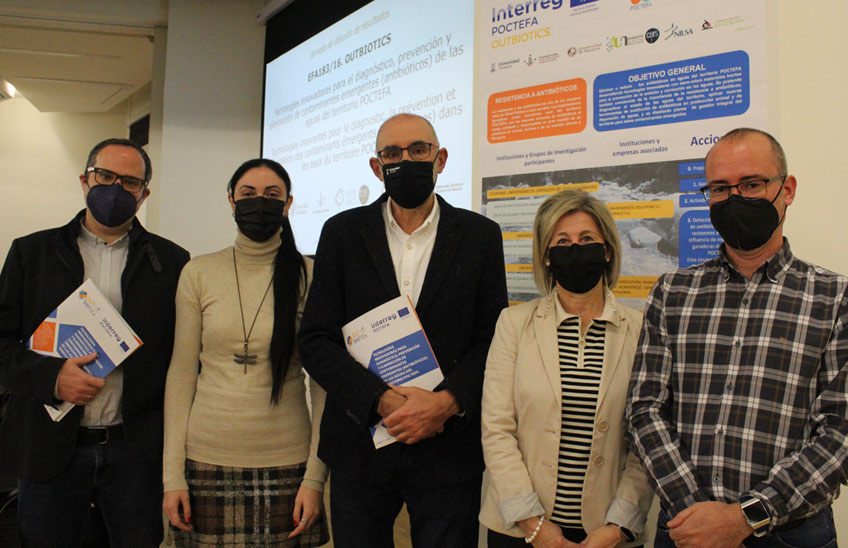The project OUTBIOTICS confirms the presence of antibiotics in rivers in the border area between Spain and France.
The study, involving the University and NILSA, has detected resistant bacteria in 96% of the rivers.

FotoCedida
/Carlos Rey Castro, from the University of Lleida; Alba Ezquerra, from Laboratorios Enosán; Francisco Laborda, from the University of Zaragoza and coordinator of project; Ana Isabel Vitas, from the University of Navarra, and Jairo Gómez, from business Navarra de Infraestructuras Locales (NILSA).
20 | 12 | 2021
The project OUTBIOTICS has confirmed the presence of antibiotics in the rivers of the border area of Spain and France (POCTEFA territory). Specifically, higher concentrations of antibiotics have been detected in rural areas of the Ebro basin, in middle or lower stretches of rivers, where intensive livestock and agricultural activity predominates as an economic engine. These are some of the conclusions of the European project OUTBIOTICS, Innovative technologies for diagnosis, prevention and elimination of emerging contaminants (antibiotics) from the waters of the POCTEFA territory.
The study, led by the University of Zaragoza, involved the University of Navarra, the University of Lleida, the Institut des sciences analytiques et de physico-chimie pour l' environnement et les matériaux (IPREM-CNRS) and business Navarra de Infraestructuras Locales S.A. (NILSA). Through this cross-border partnership consortium, the waters of Spanish and French rivers have been studied during the last four years in order to detect and quantify the presence of antibiotics and antimicrobial resistances in the area of influence of livestock farms, as well as the possibilities for the prevention of their use and their elimination.
For this study, samples were analyzed from the left bank of the Ebro and Cantabrian river basins in Spain, as well as from the Adour-Garonne river basin in France. The results obtained after the analysis of samples carried out by IPREM-CNRS have concluded that there is a higher concentration of antibiotics in the Spanish rivers studied, compared to the French ones, as well as higher concentrations of antibiotics in rural areas of the Ebro basin, in middle or low sections of the rivers, where intensive livestock and agricultural activity predominates as an economic engine, especially in waters near intensive pig and poultry farms in the sub-basin of the Segre, Gállego and Cinca rivers.
As for wastewater from large population centers, the usual presence of azithromycin, enrofloxacin and trimethoprim has been detected in the collectors of entrance to the sampled wastewater treatment plants.
Navarre participation
The department of Microbiology and Parasitology of the University of Navarra has studied the presence of high and critical priority pathogens included in the WHO list of "priority pathogens resistant to antibiotics". Bacteria resistant to the antibiotic families considered are present in 96% of the rivers and 100% of the sewage treatment plants and hospital and slaughterhouse collectors studied; 96% of the bacteria found were multi-resistant, with resistance to penicillins being the most prevalent.
The University of Navarra, together with the Universities of Zaragoza and Lleida, has also evaluated a nanomaterial based on kaolin and silver nanoparticles, developed by business Laboratorios Enosán S.L., to be used as a feed additive in animal feed, in order to reduce the incidence of infectious diseases and the use of antibiotics in livestock. The nanomaterial has been characterized by the University of Zaragoza, while the University of Navarra has been in charge of studying its antimicrobial activity and biosafety. Thus, it has been proved that the nanomaterial has antibacterial activity against a wide spectrum of bacteria, as well as against antibiotic-resistant strains. The group of Toxicology of the department of Pharmacology and Toxicology has evaluated the biosafety of the nanomaterial and has verified that it does not present genotoxicity, although it would be necessary to carry out complementary programs of study .
The University of Zaragoza, together with IPREM-CNRS and business Navarra de Infraestructuras Locales S.A., have carried out a technical and economic study of three technologies for the elimination of antibiotics in wastewater treatment plants at laboratory and at a semi-industrial pilot scale. In addition, a pilot plant has been designed and built which, by combining two of these technologies, improves the results of antibiotic removal obtained separately.
The project OUTBIOTICS has been developed since 2018, with the goal to eliminate or reduce antibiotics in the waters of the POCTEFA territory through the development of innovative technologies. The study has been co-financed by the European Regional development Fund (ERDF) through the Interreg V-A Spain-France-Andorra Program (POCTEFA 2014-2020), whose goal is to strengthen the economic and social integration of the Spain-France-Andorra border area.




